Stem cells 1
1/34
There's no tags or description
Looks like no tags are added yet.
Name | Mastery | Learn | Test | Matching | Spaced |
|---|
No study sessions yet.
35 Terms
What is a stem cell?
A stem cell can make more stem cells while also producing cells committed to undergoing differentiation.
What are the 3 criteria that class a cell as a stem cell?
Undifferentiated or unspecified
Have the ability to self-renew.
Mature and differentiate.
Draw a diagram of asymmetric self-divison.
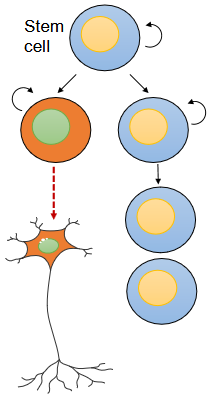
Draw a diagram of symmetric differentiating division.
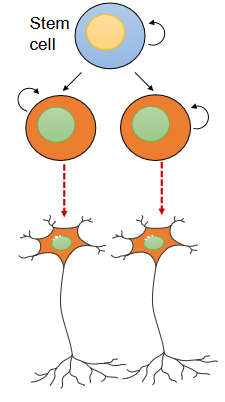
Draw a diagram of symmetric self-renewing division.
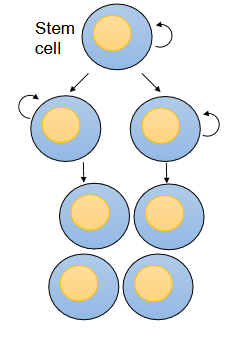
What is potency in the context of stem cells?
Potency refers to a stem cell's ability to produce different types of differentiated cells.
What is totipotency in development?
Can form all cell types, including extraembryonic tissues.
The single cell zygote, and the 4 to 8 cells embryo generates the embryo and the extraembryonic tissue.
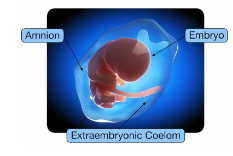
What is pluripotency?
Can form all cell types in the body (e.g., embryonic stem cells).
Inner cell mass (ICM)/ embryonic stem cells generate the embryo proper.
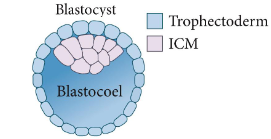
What is multipotency?
Adult or somatic (resident) stem cells. Fuel organogenesis in the embryo and regeneration in adult tissue.
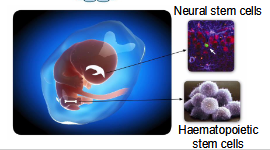
Give an example of a cell that has limited differentiation potential.
Neuronal progenitor in the brain/spinal cord.
What is the stem cell niche?
The microenvironment which influences stem cell function and behaviour.
Give different factors influencing a stem cell niche.
Paracrine signalling
Assymetric localisation of cytoplasmic determinant
Neurotransmitter release
Endocrine signalling
Juxtracrine signalling
Cell adhesion
Mechanical force
Extracellular matrix (ECM) adhesion
Epigenetic regulation
Transcriptional regulation.
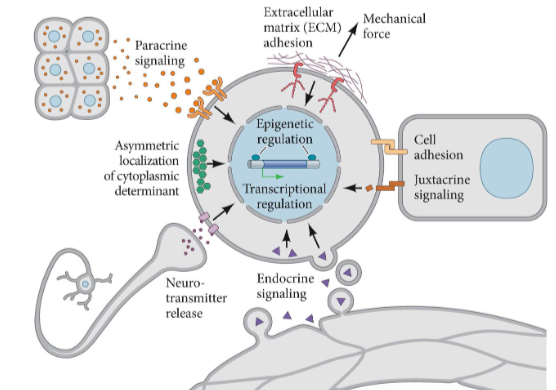
Where are embryonic stem cells isolated from? What happens after?
ICM cells extracted from blatocoel and grow on irradiated fibroblast feeder cells (plate).
These cells dissociated and replated.
They can differenitate into any cell.
What does reliably incorporating ES cells into embryos result in?
Chimeric animals carrying genetic mutations.
How can genetic mutations be introduced into the mouse germ line?
Through genetically altered ES cells. These ES cells were in every cell of their bodies.
What do ‘designer animals’ tell us?
They can mimic aspects of human disorders.
How is pluripotency maintained in ICM cells? (2)
Pluripotency factors: Key transcription factors like Nanog, Sox2, and Oct4 maintain pluripotency.
Hippo signaling: Regulated by cell density and cell-cell adhesion.
How do Oct4, Sox2 and Nanog maintain pluripotency?
They drive a pluripotency gene expression network to maintain ICM.
How is the Trophectoderm fate maintained?
through apical polarity-mediated inhibition of Hippo signaling.
How is the ICM maintained?
Maintained through cell-to-cell-mediated activation of Hippo signaling.
How does Hippo signalling work in trophectoderm cells?
Apical localization of the proteins in the partitioning defective (PAR) and atypical protein kinase C (aPKC) families
Apical polarity proteins recruit and inhibit AMOT
Inhibition of AMOT leads to Yap/Taz- TEAD-mediated gene expression of Cdx2
How does Hippo signalling work in ICM?
The scaffold protein Angiomotin(AMOT) is phosphorylated and interacts with the E-cadherin-Catenin adherens junction complex
The Hippo signalling kinase Lats1/2 is then recruited and activated, leading to repression of Yap-Taz- Tead transcriptional complex
Cdx2 repression and Oct4 activation, which promote pluripotency
What are human embryonic stem cells?
hES cells are derived from embryos that develop from eggs that have been fertilised in vitro. (never derived from eggs fertlized in a woman’s body). They are pluripotent.
What are mES cells?
They are immature, undifferentiated cells with greater potential for pluripotency than hES.
Where do hES cells display maturity?
Towards the epiblast lineage.
What are some applications of hES cells?
Organoids
Therapeutic potential
What are organoids?
‘Mini organs’ used to study human organogenesis in a dish. They can model diseases and test drugs.
What can cerebral organoids tell us?
They can model human development
What are 3 examples of how cerebral organoids can be used to understand mechanisms underlying human brain expansion?
evolutionary perspective.
pathogenesis of neurodevelopmental disorders that affect brain size determination.
debilitating neurological diseases (autism, schizophrenia).
What does Alzheimers’ effect?
Forebrain neurons.
What does Parkinson’s affect?
Midbrain neurons.
What does ALS affect?
Motor neurons.
What does cardiovascular disease affect?
Cardiac muscle cells.
What does Type I diabetes affect?
Pancreatic B cells.
Name 5 limitations of therapeutic uses of hES cells.
Difficult to differntiate uniformly and homogenously into a target tissue.
Immunogenic- may be rejected from donor.
Tumorigenic- may form tumours or promote them.
Degenerative disease- complex disorders involving interactions of many genes with environment factors.
Moral- human embryo must be destroyed to harvest its stem cells